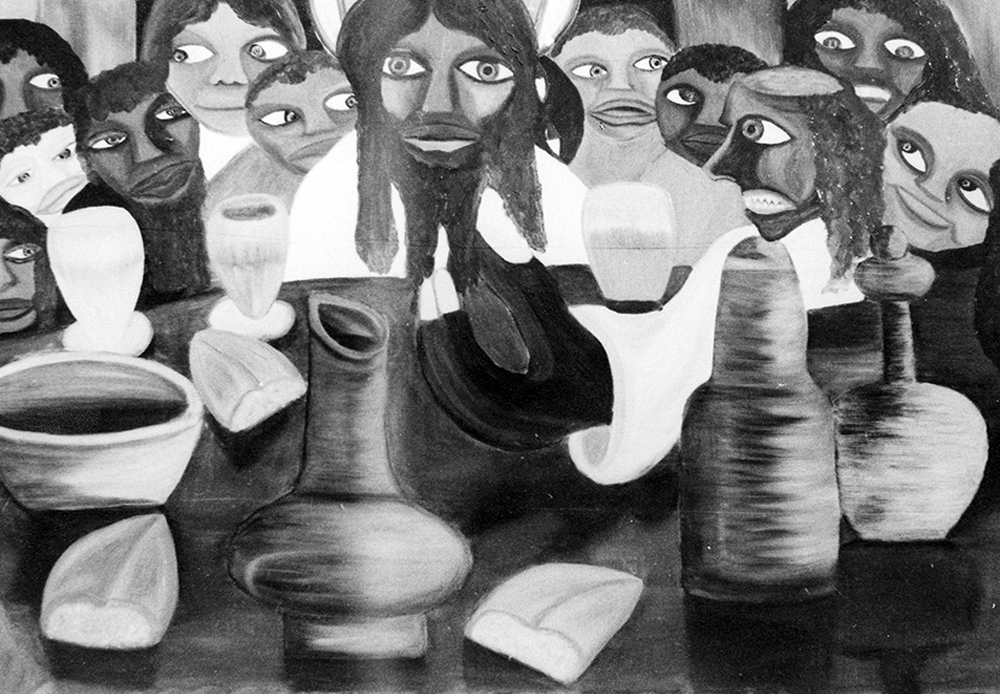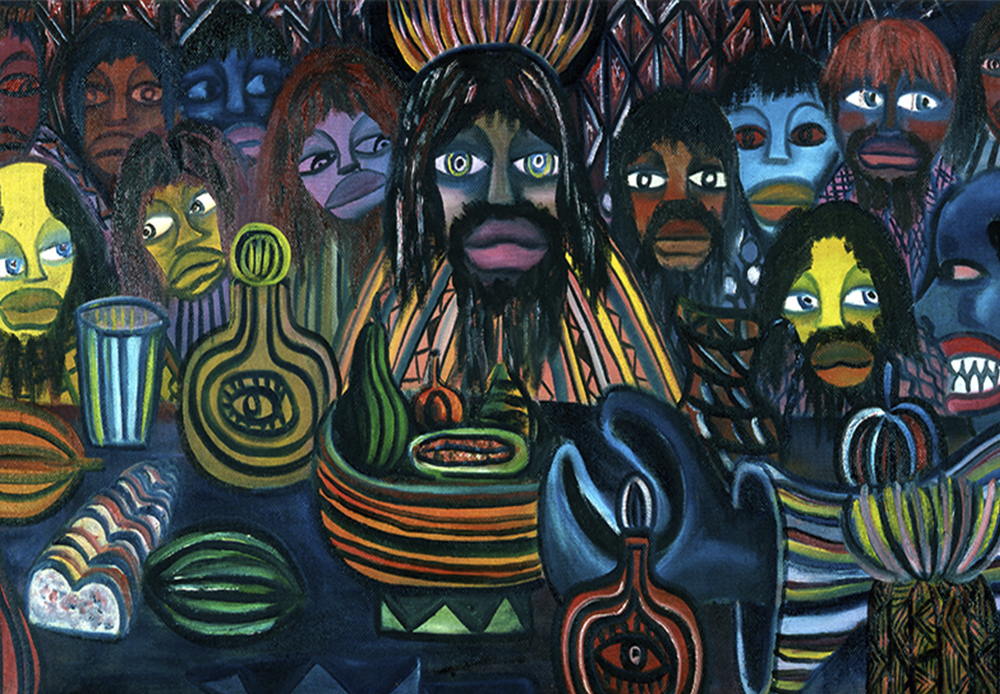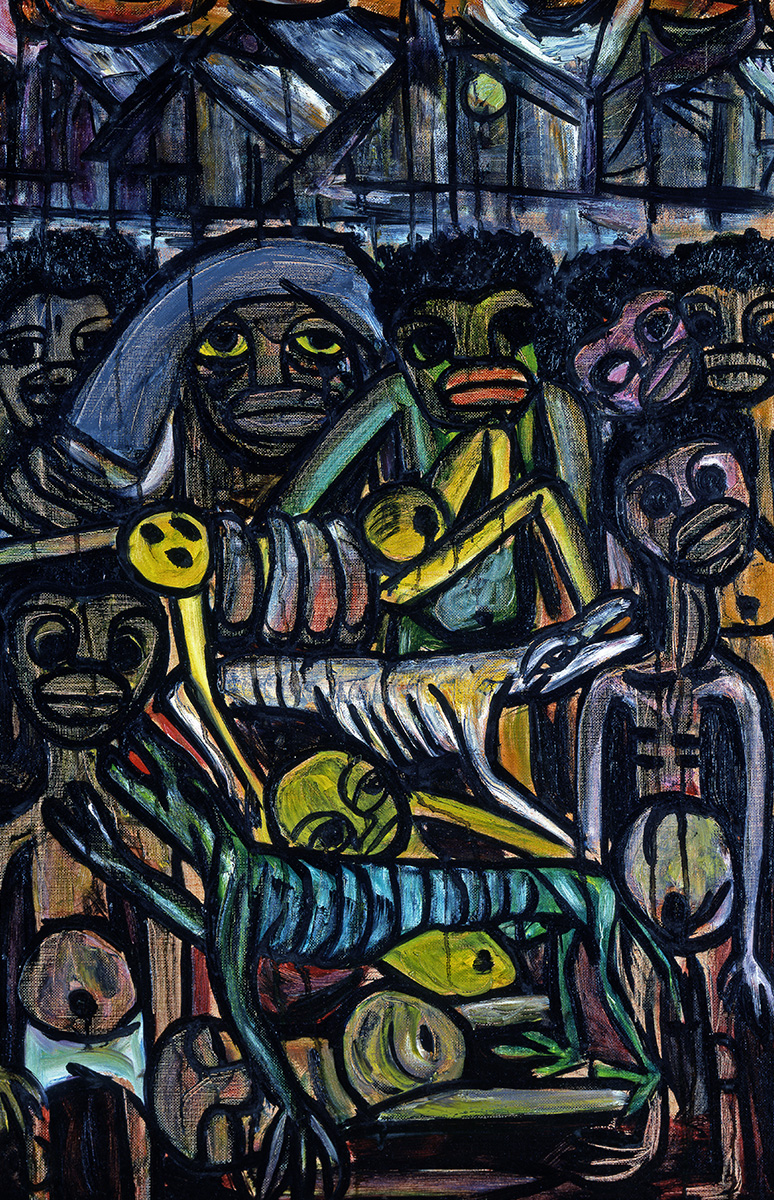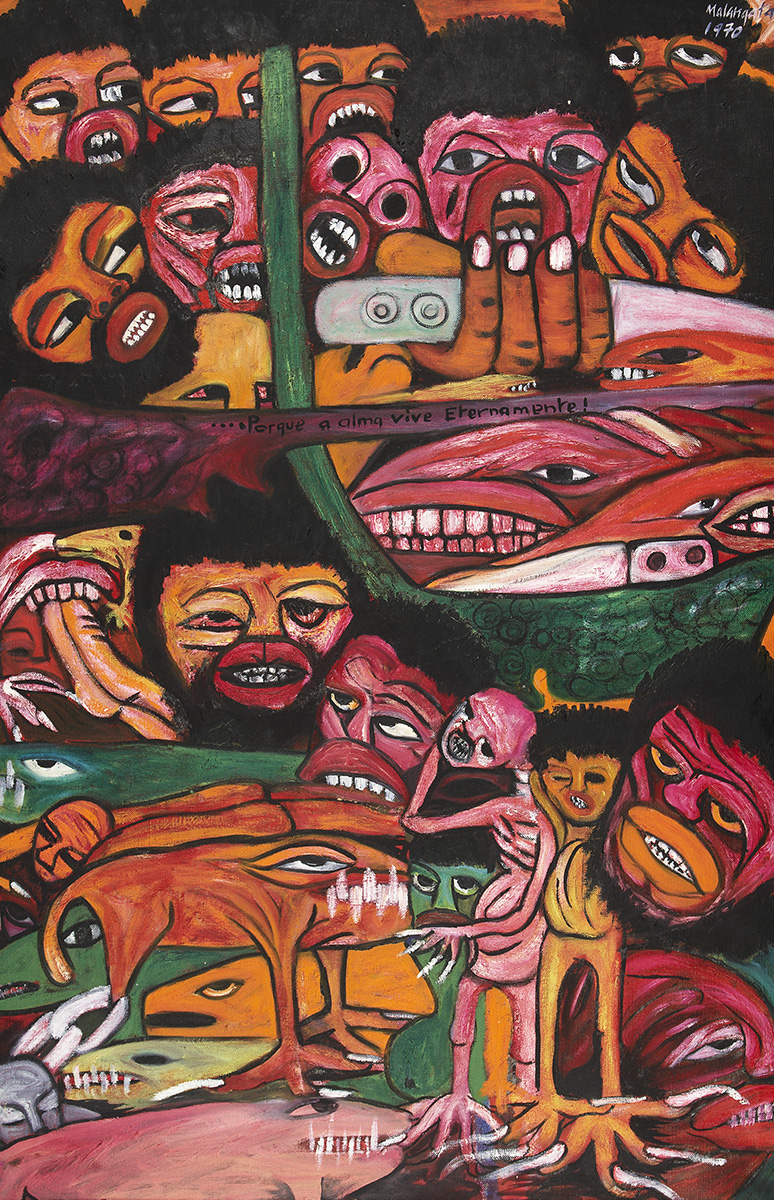The modern African art of Malangatana
Malangatana Valente Ngwenya was born on 6 June 1936 in Matalana, a village in the district of Marracuene, 40 km from Maputo, Mozambique. He attended the Swiss Mission School in Matalana, where he drew ‘things he saw in books’. In 1953, when he went to work as a waiter in the Lourenço Marques Club – or the old Grémio, as it was known – Malangatana began to ‘make watercolours of certain bald-headed bridge and tennis players’.1
At the Club, he met the painter and biologist Augusto Cabral, who became a mentor to the young man: ‘(…) he was still a boy when he asked me to teach him how to paint’.2 Around the same time Malangatana met the famous architect Pancho Guedes, who, believing firmly in the young artist’s potential, offered Malangatana the opportunity to leave his job at the Club by paying him a monthly stipend and buying a painting from him each month. Malangatana then moved into Pancho Guedes’ garage, next to latter’s architecture studio, dedicating himself there entirely to painting.3 This was in 1960, by which time Malangatana had been attending the Núcleo de Arte4 for two years.
Malangatana’s first solo exhibition in April 1961, organised at the Salão dos Organismos Económicos in Lourenço Marques, brought together 36 works listed in a catalogue (although Malangatana would later mention that he exhibited ‘fifty-seven oil paintings’).5 Nevertheless, what is important to note is that this exhibition allowed the artist to sell a series of works that gave him greater visibility as a painter.
In the small exhibition catalogue, Pancho Guedes wrote a piece which highlighted the presence of monsters and figures of a somewhat surrealist slant in Malangatana’s pictorial universe: ‘His vision has strange parallels with the European tradition. Some paintings are close to the primitive Catalans, others to the macabre apparitions of the Dutch visionaries, and still others are of an involuntary, direct and magical surrealism’.6
From this time, Malangatana continued to paint but dedicated himself equally to drawing, returning in his work to his nightmares, deliriums and dreams, and exploring myths, stories and imaginary objects. Cena de Feitiço com Casal Guedes [Scene of Sorcery with the Guedes], 1961) is one of the first paintings to feature Malangatana’s now well-known style: ‘one of the first paintings he made full of people and animals’.7
In 1961, the German anthropologist Ulli Beier, director of Black Orpheus magazine (an art and literature magazine published in Nigeria), showed photographs of Malangatana’s paintings at the Mbari Club in Ibadan, Nigeria, an important centre of cultural and artistic activity. In that same venue, in June 1962, Beier held what is considered to be the artist’s first solo exhibition outside Lourenço Marques. In the exhibition invitation, Beier highlighted architect Julian Beinart’s ‘brilliant analysis’ of the works of Malangatana in the 10th issue of Black Orpheus of 1962, an issue in which Malangatana’s first poems were also published.8 Beier comments on the strength of his painting as follows: ‘Malangatana comes from a world where witchcraft is a reality, and magical practices are to be reckoned with in one’s daily lives [sic]. Malangatana’s work is wild and powerful […and…] also contains a strong element of human sympathy and suffering and agony. […] Malangatana is anxious to communicate through his paintings. He is full of stories.’


Malangatana also participated in the exhibition Imagination 61 in Cape Town (sponsored by the Núcleo de Arte), where he exhibited the first of two works he made with the title Última Ceia (Last Supper), dated 1961. In part, this work is a still life, which through the strength of the subjects’ long, expressive eyes also reveals the artist’s religious knowledge. The flat colours and predominance of blue and white would undergo changes in the second Última Ceia,9 dated 1964 and acquired by the Gulbenkian Foundation in 1965. Here, the multiplicity of colours on the faces, the black lines and the various shades in the objects stand out in contrast to the flat colours of the 1961 painting, in which the central composition of the figures, practically all looking at us now in this second version, was originally more static.
In 1964, the year in which the war of liberation broke out in Northern Mozambique, Malangatana was accused of collaborating with FRELIMO, arrested by the Portuguese political police (known as the PIDE) and imprisoned by the harsh colonial regime for 18 months. His posterior works would reflect the monstrosity of the PIDE, as in the paintingMonstros grandes devorando monstros pequenos [Big monsters devouring small monsters], but also in a series of drawings in India ink.
Before exhibiting and becoming known in Portugal, the artist’s work was shown in several African countries and in London, where it was presented at the important exhibition Contemporary African Art at the Camden Arts Centre in 1969, reported to be the largest exhibition of African art held in the UK until that time.
Malangatana was a great connoisseur of both African rituals and myths and of Western culture alike. He travelled outside Mozambique for the first time when he received the Calouste Gulbenkian Foundation grant, arriving in Lisbon on 17 January 1971 to study engraving at the cooperative society of Portuguese printmakers, Sociedade Cooperativa de Gravadores Portugueses, first attending the lithography course with printmaker Humberto Marçal and then metal engraving classes with the master João Hogan.[10]


Malangatana held his first solo exhibition in Portugal in March 1972 at Galeria Buchholz and the Sociedade Nacional de Belas Artes (National Society of Fine Arts, or SNBA) in Lisbon. At the SNBA, he exhibited two of the paintings which today form part of the Calouste Gulbenkian Modern Collection: Porque alma vive eternamente [Because soul lives eternally] and Quando foi das cheias [The time of the floods]. Both reflect a variety of tones and figures in crowds, expressing a notion of the collective and with faces resembling wooden sculptures. Through the colourful gestures, lines of varying thickness and intense surfaces of colour, the over-sized bodies stand out. Here we can also note the influence of Mexican muralists such as José Clemente Orozco and Diego Rivera, with whose work Malangatana was familiar. As Malangatana himself said in relation to his works: ‘Horror opens the door to the fantastic.’11
1 Malangatana in NOVA magazine, issue 11, 2 January 1970, pp. 22-29. Gulbenkian Archives.
2 From a letter of recommendation written by Augusto Cabral to the director of the Fine Arts Department of the Calouste Gulbenkian Foundation on 19 March 1969. Gulbenkian Archives.
3 Amâncio d’Alpoim Guedes, ‘Lembrança do pintor Malangatana Valente Ngwenya quando ainda jovem’, in Malangatana. Lisbon: Caminho, 1998, p. 11.
4 Founded in 1936, the art centre ‘Núcleo de Arte’ was a local association of intellectuals that organised exhibitions and which included artists such as João Ayres, an influential figure in Mozambique at the time, and Garizo do Carmo, José Júlio and Pancho Guedes himself.
5 Malangatana, ‘Pancho Guedes visto por Malangantana’, in As Áfricas de Pancho Guedes: Colecção de Dori e Amâncio Guedes. Lisbon: Câmara Municipal, Sextante Ed., 2010, p. 58.
6 A. D’Alpoim Guedes, ‘O Pintor Completo’, in Malangatana Goenha Valente. Núcleo de Arte, 1961. Gulbenkian Archives
7 Amâncio d’Alpoim Guedes, ‘Lembrança do pintor Malangatana Valente Ngwenya quando ainda jovem’, in Malangatana. Lisbon: Caminho, 1998, p. 14.
8 Alexandre Pomar (accessed on 18 May 2020)
9 Currently on loan to the Art Institute of Chicago for the exhibition Malangatana: Mozambique Modern, the first exhibition of a modern African painter held at this institution.
10 Letter addressed by Malangatana on 28 June 1971 to the Foundation requesting a two-month extension of his grant and a further scholarship for six months to study at the Slade School of Art in London with the printmaker Bartolomeu Cid dos Santos. His requests were not approved, according to an official note from 20 July 1971. Gulbenkian Archives.
11 Interview with Malangatana, Lisbon: Galeria Buchholz, 1972, s.p.

